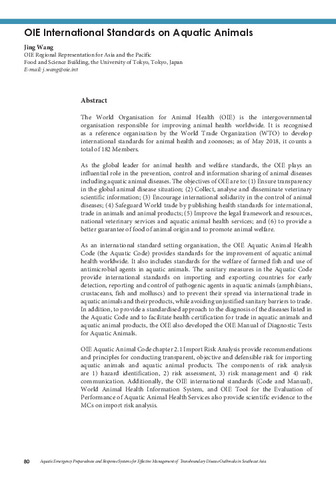Fish disease control in Japan
| dc.contributor.author | Miwa, Satoshi | |
| dc.contributor.editor | Tendencia, Eleonor A. | |
| dc.contributor.editor | de la Peña, Leobert D. | |
| dc.contributor.editor | de la Cruz, Joesyl Marie V. | |
| dc.date.accessioned | 2019-07-23T08:09:18Z | |
| dc.date.available | 2019-07-23T08:09:18Z | |
| dc.date.issued | 2019 | |
| dc.identifier.citation | Miwa, S. (2019). Fish disease control in Japan. In E. A. Tendencia, L. D. de la Peña, & J. M. V. de la Cruz (Eds.), Aquatic Emergency Preparedness and Response Systems for Effective Management of Transboundary Disease Outbreaks in Southeast Asia: Proceedings of Asean Regional Technical Consultation, 20-22 August 2018, Centara Grand Central Ladprao, Bangkok, Thailand (p. 22). Tigbauan, Iloilo, Philippines: Aquaculture Department, Southeast Asian Fisheries Development Center. | en |
| dc.identifier.isbn | 9789719931089 | |
| dc.identifier.uri | http://hdl.handle.net/10862/3458 | |
| dc.description.abstract | The regulatory authority responsible for the control of aquatic animal diseases in Japan is the Animal Products Safety Division, Food Safety and Consumer Affairs Bureau, Ministry of Agriculture, Forestry, and Fisheries (MAFF). The ministry (Animal Products Safety Division) specifies certain diseases and their host species that are subjects for import quarantine on the basis of the law called Fisheries Resources Protection Act. The MAFF also implements risk control measures for the same diseases within Japan on the basis of another law, Fish Farming Production Maintaining Act. Currently, 24 such diseases are listed. For disease control within Japan, the MAFF issues Guideline for the Control of Aquatic Animal Diseases, which states the roles of different stakeholders, appropriate actions that are to be taken on the occurrences of specified or other diseases, fish health guidelines for fish farmers, or diagnostic methods for specified diseases, etc. Local prefectural governments in Japan are required to place personnel who work on fish health issues at the prefectural fisheries research laboratories. These people usually inspect fish farms, observe cultured aquatic animals, supervise the use of antibiotics or vaccines, and guide fish farmers for disease control. Disease diagnosis for aquatic animals is usually conducted by these local fisheries research labs for free. The Japan Fisheries Resource Conservation Association provides a comprehensive training course on fish diseases including laws or hands-on trainings for the staff of prefectural fisheries research laboratories. The JFRCA also give local fish health personnel the qualification as the fish health expert, if the person passes the examination conducted after the training course. Primary diagnosis for specified diseases is conducted by local fisheries laboratories. On the occurrence of the diseases that are suspected to be one of the specified diseases or OIE listed diseases that have not been reported in Japan, the samples are sent to the National Research Institute of Aquaculture (NRIA) where confirmatory diagnosis is made. When such diseases are confirmed, it is reported to the MAFF (or to the OIE through MAFF). For specified diseases, Fish Farming Production Maintaining Act enables local governments to implement necessary measures to prevent the disease from spreading, including issuing orders such as to stop the transfer of the animals to other watersheds, to destroy animals, or to disinfect the facilities. When an unknown disease is encountered by a prefectural fisheries research laboratory, the NRIA is requested to conduct diagnosis. The NRIA develops diagnostic methods for new diseases and disseminate the techniques to local fisheries research laboratories. The NRIA provide positive control materials for disease diagnosis, hands-on trainings of specific subjects concerning diagnostic techniques, or proficiency tests for the fish health personnel of the local fisheries research laboratories. | en |
| dc.language.iso | en | en |
| dc.publisher | Aquaculture Department, Southeast Asian Fisheries Development Center | en |
| dc.subject | Japan | en |
| dc.title | Fish disease control in Japan | en |
| dc.type | Conference paper | en |
| dc.citation.spage | 22 | |
| dc.citation.conferenceTitle | Aquatic Emergency Preparedness and Response Systems for Effective Management of Transboundary Disease Outbreaks in Southeast Asia: Proceedings of Asean Regional Technical Consultation, 20-22 August 2018, Centara Grand Central Ladprao, Bangkok, Thailand | en |
| dc.subject.asfa | disease control | en |
| dc.subject.asfa | disease recognition | en |
| dc.subject.asfa | disease resistance | en |
| dc.subject.asfa | disease transmission | en |
| dc.subject.asfa | epidemiology | en |
| dc.subject.asfa | husbandry diseases | en |
| dc.subject.asfa | aquaculture regulations | en |
| dc.subject.asfa | quarantine regulations | en |
| dc.subject.asfa | policies | en |
| dc.subject.asfa | fishery policies | en |
| dc.subject.asfa | safety regulations | en |
| dc.subject.asfa | fish diseases | en |
| dc.subject.asfa | public health | en |
| dc.subject.asfa | food safety | en |
| dc.subject.asfa | fisheries | en |
| dc.subject.asfa | fish | en |
| dc.subject.asfa | workers | en |
| dc.subject.asfa | watersheds | en |
| dc.subject.asfa | training | en |
| dc.subject.asfa | laboratories | en |
| dc.subject.asfa | animal diseases | en |
| dc.subject.asfa | fish culture | en |
| dc.subject.asfa | aquaculture | en |
| dc.subject.asfa | resource conservation | en |
| dc.subject.asfa | methodology | en |
| dc.subject.asfa | animal products | en |
| dc.subject.asfa | vaccines | en |
| dc.subject.asfa | research | en |
| dc.subject.asfa | antibiotics | en |
| dc.subject.asfa | aquatic animals | en |
Files in this item
รายการนี้ปรากฏใน (s)
-
Aquatic Emergency Preparedness and Response Systems for Effective Management of Transboundary Disease Outbreaks in Southeast Asia [20]
Proceedings of ASEAN Regional Technical Consultation, 20-22 August 2018, Centara Grand Central Ladprao, Bangkok, Thailand





